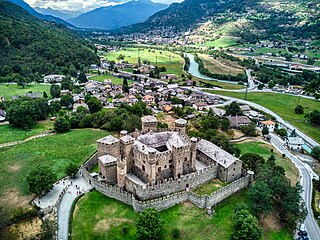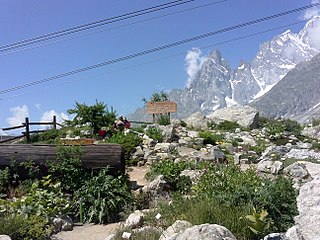Related Research Articles

An abbey is a type of monastery used by members of a religious order under the governance of an abbot or abbess. Abbeys provide a complex of buildings and land for religious activities, work, and housing of Christian monks and nuns.
The Benedictines, officially the Order of Saint Benedict, are a mainly contemplative monastic order of the Catholic Church for men and for women who follow the Rule of Saint Benedict. Initiated in 529 they are the oldest of all the religious orders in the Latin Church. The male religious are also sometimes called the Black Monks, especially in English speaking countries, after the colour of their habits. Not all Benedictines wear black however, with some like the Olivetans wearing white. They were founded by Benedict of Nursia, a 6th-century Italian monk who laid the foundations of Benedictine monasticism through the formulation of his Rule. Benedict's sister, Scholastica, possibly his twin, also became a religious from an early age, but chose to live as a hermit. They retained a close relationship until her death.

The Great St Bernard Pass is the third highest road pass in Switzerland, at an elevation of 2,469 m (8,100 ft). It connects Martigny in the canton of Valais in Switzerland with Aosta in the region Aosta Valley in Italy. It is the lowest pass lying on the ridge between the two highest mountains of the Alps, Mont Blanc and Monte Rosa. It is located on the main watershed that separates the basin of the Rhône from that of the Po.

The Aosta Valley is a mountainous autonomous region in northwestern Italy. It is bordered by Auvergne-Rhône-Alpes, France, to the west; by Valais, Switzerland, to the north; and by Piedmont, Italy, to the south and east. The regional capital is Aosta.

Aosta is the principal city of the Aosta Valley, a bilingual region in the Italian Alps, 110 km (68 mi) north-northwest of Turin. It is situated near the Italian entrance of the Mont Blanc Tunnel and the Great St Bernard Tunnel, at the confluence of the Buthier and the Dora Baltea, and at the junction of the Great and Little St Bernard Pass routes.

The Little St Bernard Pass is a mountain pass in the Alps on the France–Italy border. Its saddle is at 2188 metres above sea level. It is located between Savoie, France, and Aosta Valley, Italy, to the south of the Mont Blanc Massif, exactly on the main alpine watershed. There is also a Great St. Bernard Pass, famous for giving the St Bernard breed its name, and a San Bernardino Pass.

The St. Bernard or Saint Bernard is a breed of very large working dog from the Western Alps in Italy and Switzerland. They were originally bred for rescue work by the hospice of the Great St Bernard Pass on the Italian-Swiss border. The hospice, built by and named after the Alpine monk Saint Bernard of Menthon, acquired its first dogs between 1660 and 1670. The breed has become famous through tales of Alpine rescues, as well as for its large size and gentle temperament.

Gotthard, also known as Gothard or Godehard the Bishop, was a German bishop venerated as a saint.

The Order of Saint Lazarus of Jerusalem, also known as the Leper Brothers of Jerusalem or simply as Lazarists, was a Catholic military order founded by Crusaders during the 1130s at a leper hospital in Jerusalem, Kingdom of Jerusalem, whose care became its original purpose, named after its patron saint, Lazarus.

Bernard of Menthon or Bernard of Aosta was a Burgundian Catholic priest and founder of the Great St Bernard Hospice, as well as its associated Canons Regular of the Hospitaller Congregation of Great Saint Bernard.
The Canons Regular of St. Augustine are priests who live in community under a rule and are generally organised into religious orders, differing from both secular canons and other forms of religious life, such as clerics regular, designated by a partly similar terminology. As religious communities, they have laybrothers as part of the community.

Barry der Menschenretter (1800–1814), also known as Barry, was a dog of a breed which was later called the St. Bernard that worked as a mountain rescue dog in Switzerland and Italy for the Great St Bernard Hospice. He predates the modern St. Bernard, and was lighter built than the modern breed. He has been described as the most famous St. Bernard, as he was credited with saving more than 40 lives during his lifetime, hence his byname Menschenretter meaning "people rescuer" in German.

La Thuile is a town and comune in the Aosta Valley of northwest Italy.

Mont Vélan is a mountain of the Pennine Alps, located on the border between Switzerland and Italy. At 3,727, metres Mont Vélan is the highest summit lying between the Great St Bernard Pass and Grand Combin. Two large glaciers cover its northern flanks: Glacier de Tseudet (west) and Glacier de Valsoray (east). The Glacier de Proz, lying on the west side, was traversed during the first ascent.
The Savoy Castle Alpine Botanical Garden is an alpine botanical garden located at 1350 meters altitude on the grounds of Savoy Castle, Gressoney-Saint-Jean, Aosta Valley, Italy. It is open daily in the warmer months.

The alpine botanical garden Saussurea is the highest alpine botanical garden in Europe, at 2,173 metres above sea level. It is located in Courmayeur, Aosta Valley, Italy. The Saussurea garden is one of the four alpine botanical gardens in the Aosta Valley, and its 7,000 square metres contain the typical alpine flora of Mont Blanc. Its name comes from Horace-Bénédict de Saussure, who made the first known ascent of Mont Blanc in 1786, and from whom the flower Saussurea alpina also takes its name. It is open from June to September.

The Chanousia Alpine Botanical Garden is an alpine botanical garden located at 2170 meters altitude near Mont Blanc, at the Little St Bernard Pass. Though located in France, it belongs to the Italian commune of La Thuile. It was founded by Valdostan abbot and botanist Pierre Chanoux. It is open daily in the warmer months.

The Great St Bernard Tunnel is a road tunnel complementing the Great St Bernard Pass, linking Martigny with Saint-Rhémy-en-Bosses.

The Great St Bernard Hospice, named after its founder Bernard of Menthon, is a hospice and hostel for travelers at the Great St Bernard Pass in Switzerland. At an elevation of 2,469 m (8,100 ft) in the Pennine Alps, it is located a few hundred metres north from the border with Italy. It is part of the municipality of Bourg-Saint-Pierre in the Swiss canton of Valais.
References
- ↑ Rivista enciclopedica contemporanea, Editore Francesco Vallardi, Milan, (1913), entry by D Fava, pages 292-293.
- ↑ Encyclopedia Treccani, Dizionario Biografico degli Italiani, Volume 24 (1980); entry by Federico Di Trocchio.
- ↑ La Rosière Tourist Office, entry of Petite St Bernard.